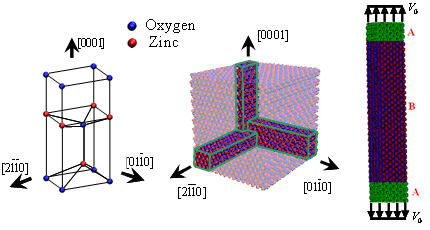Thermomechanical Behavior of Zinc Oxide Nanobelts
|
The current research focuses on characterizing the thermo-mechanical response of zinc oxide (ZnO) nanowires and nanobelts which are a new class of one-dimensional (1D) nanostructures. Recently fabricated through vapor-solid deposition techniques, these nanostructures have potential applications as functional nanocomponents such as catalysts, chemical & biomedical sensors, resonators, transparent conductors, and nano-electronic/photonic interconnects in nano-electro-mechanical systems (NEMS). The motivation for this work stems from the dearth of information regarding the thermo-mechanical responses of these nanostructures essential for their incorporation in nanosystems and the lack of nanoscale experimental setups for such characterizations. In the present work, an atomistic framework has been developed to extract the coupled thermo-mechanical behavior of the ZnO nanostructures. Key considerations are the effects of size and temperature on the elastic modulus, tensile strength and thermal conductivity. The surface dominance of mechanical (effect of surface stress) and thermal (effect of surface scattering of phonons) behaviors arising from the high surface-to-volume ratio at the nanoscale are analyzed. Novel phase transformations observed in nanowires under tensile loading are characterized and related effect on the mechanical (elastic moduli, yield and fracture strength) and thermal properties (specific heat and thermal conductivity)are charcterized. Such size dependency of properties at the nanoscale and the tensile-stress-induced phase transformations significantly alter the responses of the nanowires as compared to their bulk counterparts and offer potentials for novel applications in NEMS that rely on thermomechanical responses. Quantification of this phenomenon should provide data and criteria for the design and fabrication of a range of building blocks for nanoscale devices. FIGURE 1. (a) unit cell of ZnO, (b) orientations of nanobelts, and (c) loading scheme Papers:
Quasistatic tensile loading of [2-1-10] orientaion nanobelts Quasistatic tensile loading of [01-10] orientation nanobelts Quasistatic tensile loading of [0001] orientaion nanobelts Reversible structural transformation in [01-10] orientation nanobelts |
